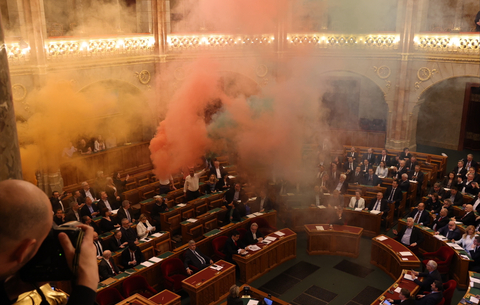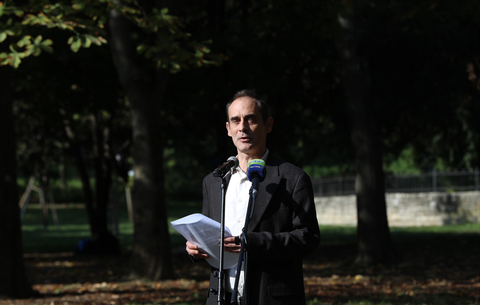The majority is cutting out the branch from beneath them
Hungarian Roma are unwilling to get into arguments with the local authorities on whom they depend, prefering to put up with legal abuses, according to Erzsebet Mohacsi, a 33-year-old Roma civil rights lawyer.
© Fazekas István |
Things look more serious than a few years ago. I'm often in the provinces, and the atmosphere is threatening. I can see it from individuals' stories as well: it is not good to be a Roma in Hungary.
Was it easier for your generation than for today's Roma children?
I was born in the village of Bedo, which is an unusual place in that Hungarians are a minority next to the Romanian and Roma populations. One of the best-known family of Roma intellectuals, the Daroczis, come from here, and they were a source of inspiration to the entire community. My family didn't even have a potato patch, giving us an even greater incentive to study. There was never any question of anybody in my family not finishing high school. But today's Roma children see no advantage in studying, because after their eighth year, they are likely to end up in a technical school offering a completely useless qualification leading inevitably to unemployment. It is characteristic that the Fazola school in Miskolc, which was once very mixed and enjoyed a good reputation, is now an almost completely segregated Roma school.
Your foundation became known when it took to court several cases involving segregated schools in Miskolc. The court found in your favour, but it's almost as if the local community is unhappy with a decision which should be to their benefit.
Roma parents are frightened of standing up for their rights. They get financial support and jobs from local authorities, so they are unwilling to stand up to them. In Miskolc, some Roma parents started a petition to preserve one of the Roma schools we wanted to close, even though they know that mixed schools give their children a far better start in life. Furthermore, the mayor's office spent a large sum of money on modernising the school in question. Then they hired the parents who did not want their children to attend that school to paint the classrooms. We tried to encourage them to insist on an end to segregation, but they lost their initial enthusiasm at the first obstacle.
When does the critical mass come that kicks off the segregation process?
If every fourth child in a class is Roma, then in big cities the non-Roma children start to leave, without regard for any other factor. But it's not difficult to see that this majority is cutting the branch from underneath itself. If ever more Roma children are forced into a segregated school, then most of them will be unemployed and depend on society to support them. If they are given a chance to finish school - something only every tenth Roma child manages at the moment, compared to 80 per cent of the non-Roma - then they have a much better chance of finding work. And then they are not dependent on welfare payments - they are paying taxes.
This matches up with the numbers recently published by Gabor Kertesi and Gabor Kezdi. They showed that getting a disadvantaged child to finish high school saved several tens of millions of forints from the budget. But what practical steps can be taken to bring this about?
© Fazekas István |
We see prejudice in so many areas of life. Why are you focusing on education?
Of course it's a multi-faceted problem - you have to act against inequality of opportunities in employment and health as well. But you can't do it all at once. If you can bring about changes in education, then this generation will already have better opportunities. When Balint Magyar was education minister, there was a ministerial commissioner responsible for promoting integration, but one of Istvan Hiller's first acts was to abolish this post. I don't think that's a good message.
Isn't it discouraging that some of the measures you've used, like taking local authorities to court, have been poorly received by some sociologists?
There was indeed a researcher who wrote a brilliant study of segregation at schools in Miskolc and Nyiregyhaza, but he didn't want us to use that study in the trial, and he also refused to testify. But some of these people have changed their attitude now that they've seen the results. We managed to get a segregated school closed in Hajduhadhaza after 10 years, which is what local Roma had been demanding. For us, trials are just a tool to get us into a position where we can negotiate. Most of our work involves convincing local communities.
Demographic trends point to a pattern of internal migration which will create large, majority Roma areas in north east Hungary. Will it one day be worth creating some kind of autonomous Roma region?
I hadn't thought of that. It's true that with the accession of Romania and Bulgaria to the EU there will be some 12m Roma in the Union, but any talk of autonomy seems unrealistic for the moment. We are focused on integration. I've never felt the need to say I'm from an independent Roma country in order to affirm my Roma identity. All Hungarians can be proud of some of our leading Roma figures, like Laci Papp or the actor Sandor Csanyi.
GERGELY FAHIDI
English version
hvg.hu
2006. november. 15. 10:25
The Free Democrat party is on the wrong tack
English version
hvg.hu
2006. november. 30. 16:12
László Tamás Papp
English version
hvg.hu
2006. november. 27. 12:53
Orbans eye on Kosa
English version
2006. november. 30. 11:20
Scandals at the Hungarian universities
English version
HVG
2006. november. 29. 18:29
Mourning
English version
hvg.hu
2006. november. 29. 18:32









